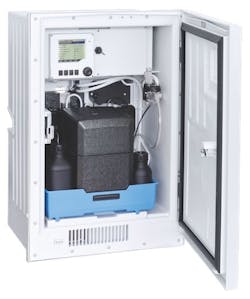Water resource recovery plants must monitor ammonium and orthophosphate. Permitted levels for these nutrients in effluent discharge are becoming increasingly tight because state environmental agencies and the U.S. Environmental Protection Agency (EPA) are requiring dischargers to reduce the amount of nutrients in their effluent.
Photometric/colorimetric analyzers (see Figure 1, page 18) can be used to monitor ammonium and orthophosphate. Keys to the success of a colorimetric analyzer installation are proper application and maintenance of the instrument.
These instruments typically provide lab-quality results that are EPA-compliant. Functionally, an analyzer receives a sample extracted from the process, and combines the sample with reagents that react with the ammonium or orthophosphate, resulting in a specific sample color. In addition to the colorimetric reagents and calibration standard, instruments also typically employ a solution to periodically clean the system and photometer.
Color intensity is directly proportional to ammonium or orthophosphate levels. The intensity is measured photometrically, and the ammonium or orthophosphate level is determined using a calibration curve, based on a standard calibration solution.
Operating a photometric/colorimetric analyzer does not have to be an expensive proposition. Here are some tips for the proper application and maintenance of a photometric/colorimetric analyzer to reduce cost of ownership.
1. Sample Preparation System Design
A well-designed sample preparation system ensures a proper sample is provided to the analyzer. It is the first step to a successful photometric/colorimetric analyzer installation.
Sample preparation systems are comprised of a filter immersed in the process, and a pump to extract a sample and deliver it to the analyzer (see Figure 2, page 19). The filter should be positioned to ensure it is extracting a representative sample, and it should be easily accessible and easy to clean.
Some systems offer automatic cleaning with air or chemical backwash. Chemical cleaning can be critical in an influent installation where greases or oils can be present along with high biological activity, all of which can lead to filter or sample line plugging. For freezing weather environments, the sample system tubing should have a heating option. Sample system filters, tubing and pumps should not only be reliable, but easy to clean and service.
2. Analyzer Chemical Management
Analyzers consume reagent chemicals, and their operational costs rise and fall with reagent consumption. Each internal cleaning and calibration cycle also consumes chemicals. In some analyzers, the rate of cleaner consumption increases along with water hardness, adding to the cost of operation.
The more reagent consumed with each analysis, the higher the operating cost of the analyzer. The less reagent used with each analysis, the longer a bottle of reagent will last, and the lower the cost of operation. Some systems offer internal reagent cooling systems to help extend the life of reagents. Newer analyzer designs, with more precise reagent dosing systems, are capable of reducing chemical costs to less than $200 a month. The analyzer should also track reagent use, and provide indication when it’s time to replace it.
The reagents required by the analyzer should be easy to prepare and have a long shelf life after preparation and installation. A longer shelf life allows bulk purchase of materials well in advance, which can reduce cost.
3. Component Wear and Service
Distributing samples and chemicals within a photometric/colorimetric analyzer requires tubing, pumps and valves. Some analyzers will employ stirring systems. Users should examine the expected lifetime of each of these wear components as stated by the vendor. Overall cost of ownership is highly dependent on the number of wear parts, their frequency of replacement, and cost of each.
Some analyzers need extensive part replacement using an array of tools. Newer analyzers are designed to reduce the number parts requiring service, eliminate the need for tools, and reduce the time required to perform routine maintenance. All these features help keep the cost of ownership low, minimize analyzer downtime, and reduce requirements for specialized labor.
4. Control System Integration
Today, a range of output options exist to bring data from photometric/colorimetric analyzers to a control system. In addition to the traditional analog (4-20 mA) outputs, systems are available with a range of fieldbus digital communications, such as Profibus, Modbus or EtherNet/IP. Additionally, some systems provide the ability to integrate other sensor measurements within the analyzer, expanding the functionality of the analyzer and reducing the capital costs for additional measurement values.


